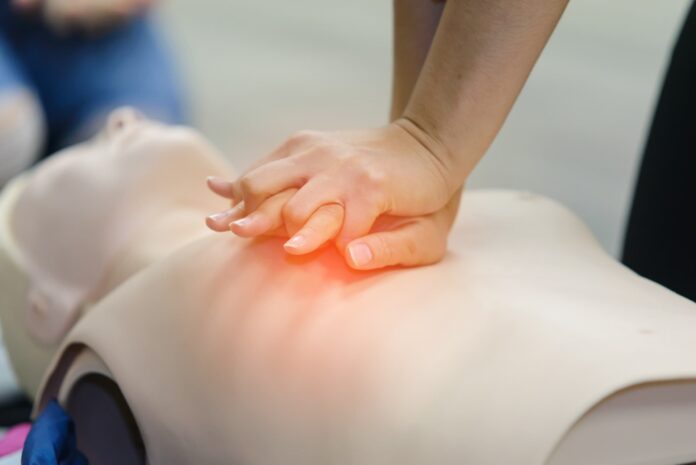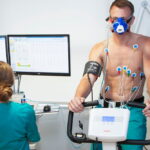Cardiopulmonary Resuscitation CPR
Every person is exposed to a case of cardiac arrest for some reason, and the person whose heart stopped maybe your colleague at work, your father, or your grandfather, and the injured person may be a stranger whom you just watched fell to the ground.
Whether a person whose heart has stopped can be saved depends on the first person who saw what happened. Every minute that passes on the injured person without an ambulance reduces the chances of this injured person surviving, so the time here is critical and means life or death for that person.
The human brain and heart cannot bear the interruption of blood and oxygen for more than (6) six minutes, as the brain and heart cells begin to die after these six minutes have passed.
It should be noted that even in developed countries, it takes 8 to 10 minutes for the ambulance to reach the place of the injured person.
Every minute delay in starting the ambulance operation or attempting CPR reduces the chances of his heart returning to work by 10 percent, meaning that by 10 minutes without starting the ambulance, the chance of the injured person surviving becomes very small, if not existent.
The importance of cardiopulmonary resuscitation (CPR) is reflected in the fact that it supplies the heart and brain with blood and oxygen to increase the chances of the patient’s survival.
In our contemporary society, it has become a moral obligation for an adult to provide assistance to those who need this help, and the person and his knowledge of how to rescue or rescue the injured is extremely necessary. The life of a human being (near or far) may depend on the help that can be provided to him, and the reward for saving a person’s life is not limited to the reward in this world.
Moreover, this skill can be utterly valuable as accidents happen constantly. Giving the injured this immediate intervention before car accident doctors can see them can spell the difference between life and death. Ultimately, the potential to restore life and give somebody a second chance to live is a gift you can offer to others. So, learning this technique can be extremely gratifying.
What is CPR?
CPR is a dual process in which the paramedic resuscitates the lung and heart.
CPR is a life-saving technique performed on individuals who’ve experienced sudden cardiac arrest that causes their hearts to stop beating effectively. It combines chest compressions with rescue breaths. The manual interference creates artificial blood and oxygen circulation throughout the body to maintain vital organ function until advanced medical help arrives.
As for lung resuscitation, it is carried out by delivering air and oxygen to it through artificial respiration, and as for cardiac resuscitation, it is done by manual pressure on the patient’s heart area (in the area between the thoracic bone and the spine) so that blood is pumped to the vital parts of the injured body, especially the brain.
What is Cardiac Arrest?
It is the sudden stopping of the heart from beating, thus stopping the process of pumping blood to the lungs, brain and other organs.
Symptoms of cardiac arrest include:
- Unconsciousness.
- respiratory failure.
- Pulse stops.
- Irregular breathing patterns.
Recognizing the gravity of the situation and the urgency required to provide critical assistance underscores the vital importance of CPR in sustaining life. It offers essential reinforcement until the individual is given proper medical care. By promptly recognizing cardiac arrest and initiating immediate CPR, individuals can contribute to the chain of survival and significantly improve the chances of a positive outcome.
What are Stunted Lungs?
It is the sudden cessation of the lungs from working (breathing), and thus the entry of air into the lungs stops, and therefore oxygen is cut off from the lungs and the rest of the body’s organs. Among the symptoms of complete cessation of the lungs are the following:
- Unconsciousness.
- respiratory failure.
Check Also:
- How to Find a 5-Star Dentist Near You

- Your Easy-Peasy Guide to Brewing Amazing Matcha

- Embracing Holistic Wellness: Insights from a Lansing, MI Health Center

- VO₂ Max Testing Explained: What It Is & Why It Matters for Your Health

- So, what exactly is matcha?

What are the Causes that Lead to the Occurrence of Cardiopulmonary Arrest?
There are many causes that lead to the occurrence of cardiopulmonary arrest, including the following:
- Diseases / heart problems / heart attack.
- Respiratory diseases/problems.
- Electric shock.
- intoxication.
- Drowning/suffocation.
- heart attack.
- Severe bleeding and/or severe shock.
- Severe physical trauma
- Arrhythmia
- Severe infections such as sepsis
- Congenital heart defects
The list isn’t exhaustive. It’s important to note that cardiac arrest may also happen to people with no pre-existing heart conditions.
How do You Rescue/Resuscitate a Person with a Cardiac or Lung Arrest?
Basic Steps
1- Make sure that you are in a safe position if you approach the injured, beware that you become injured.
2- Try to see if the injred person is able to respond or not, and try to wake him up by shrugging his shoulders and calling him loudly and close to his ears.
3- Ask for help from those around you or from passers-by. Call for help even if you don’t see anyone near you. If someone responds to the call for help, ask him to wait near you until you assess the condition of the injured person.
4- Place the patient on the floor or a hard surface and remove any pillows under his head. Be careful if you are dealing with a patient who has lost consciousness after hitting something like an accident.
The Procedures of Cardiopulmonary Resuscitation CPR
5- Make sure the airway is open, use the head tilt and chin lift technique. To make sure that the airway is open, follow these steps:
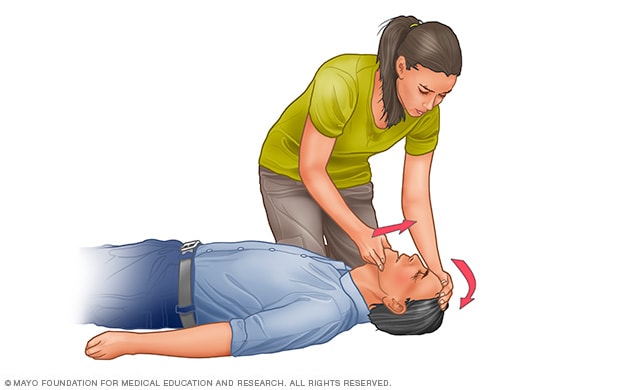
- Place two fingers of one of your hands under the chin of the victim and raise his head up.
- Place the palm of your other hand on the victim’s forehead and press down.
- Look inside the victim’s mouth to make sure that his mouth is free of any foreign body, artificial teeth (dentures), or mucus.
- If the victim suffers from shock or bruising, you should avoid moving his neck and try to open the airway by applying pressure to the jaw.
6- Check for 10 seconds whether the patient is breathing or not, using the following methods:
- Check by looking to note the rise and fall of the chest.
- Hearing check by placing your ear close to the mouth and nose of the injured person.
- Check by feeling so that you feel the injured person’s exhalation on your cheek.
7- Is the patient is breathing or not ?
- If the patient is breathing, put him in the rescue position and wait for the ambulance.
- If the patient is not breathing:
- Ask the person who is helping you to call an ambulance and get back to where you are as soon as possible. If there is no one to help you, go and call the ambulance yourself.
- Perform artificial respiration by blowing into the injured person’s mouth twice slowly, in a manner called (the kiss of life), over a period of one and a half to two seconds.
- Watch the patient’s chest rise after blowing into his mouth and wait until his chest drops between the first and second blows.
8- If you are trained to feel the carotid pulse, do it for 10 seconds, as follows:
- Feel the larynx (Adam’s apple) in the neck using two fingers of your hand.
- Pass your fingers in the course of the throat and press a little to feel the pulse, but if you are not trained to feel the pulse, look for any signs of life on the patient.
9- Are there signs that the patient is still alive or that the patient’s heart is still beating?
- If the answer is yes, then you must continue to try to save the victim by giving him artificial respiration once every (5) five seconds until the ambulance arrives.
- If the answer is no, then do the following:
Press on the chest of the victim with the aim of returning his heart to work 30 times, by following the following instructions:
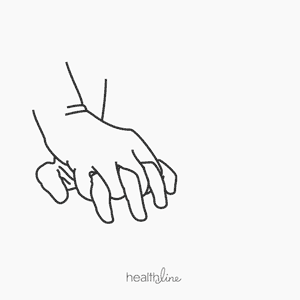
- Feel the outer edge of the victim’s lower rib by placing your hands on either side of his rib cage.
- With the fingers of your hand, trace the borders of the lower ribs until your fingers meet at the chest bones of the victim.
- Place your middle finger (from your hand toward the patient’s feet) on the breastbone, then place your index finger next to the middle finger.
- Place the palm of your other hand on the injured person’s chest in place of the middle and index fingers.
- Place your other hand on top of your palm, interlocking the fingers of both hands.
- Keep your body in a position where your shoulders and elbows are perpendicular to your hands. Make sure that your arms and back are in a straight position, then start applying pressure on the chest bone of the victim using your back muscles, not your arms.
- Press the chest down 4 to 5 cm at a rate of 80 to 100 times per minute.
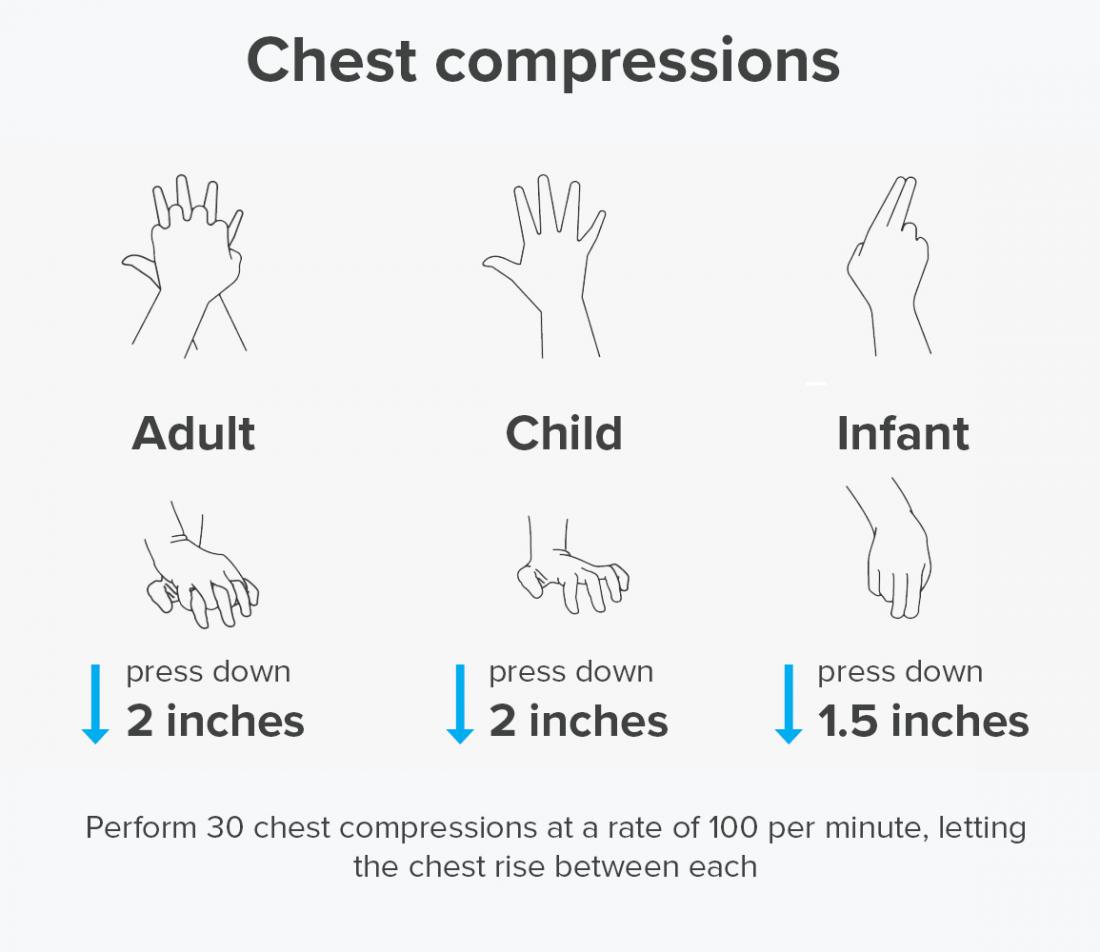
10 – Give CPR two more times. Continue to give 1 minute of CPR (4 cycles of 15 compressions to CPR and 2 puffs to CPR) and then check the pulse.


